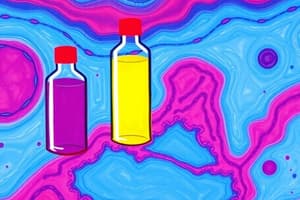Podcast
Questions and Answers
What is the primary component of nuclear fixatives that preserves nuclear structures?
What is the primary component of nuclear fixatives that preserves nuclear structures?
- Absolute Ethyl Alcohol
- Glacial acetic acid (correct)
- Formalin
- Acetone
Which fixative should be avoided in cytoplasmic fixatives to prevent damage to mitochondria and Golgi bodies?
Which fixative should be avoided in cytoplasmic fixatives to prevent damage to mitochondria and Golgi bodies?
- Flemming's fluid with acetic acid (correct)
- Orth's fluid
- Regaud's fluid
- Kelly's fluid
Which substance has been found to react with viruses and reduce their infective power?
Which substance has been found to react with viruses and reduce their infective power?
- Acetone
- Chromium salts
- Ethanol
- Mercuric chloride (correct)
What is the purpose of secondary fixation in histological preparations?
What is the purpose of secondary fixation in histological preparations?
In secondary fixation, what is the specific role of Zenker's solution?
In secondary fixation, what is the specific role of Zenker's solution?
What is the purpose of post-chromatization as a form of secondary fixation?
What is the purpose of post-chromatization as a form of secondary fixation?
Which group of fixatives acts by cross-linking proteins?
Which group of fixatives acts by cross-linking proteins?
What type of fixatives are made up of only one component substance?
What type of fixatives are made up of only one component substance?
Which fixative is a protein-denaturing agent?
Which fixative is a protein-denaturing agent?
Which fixative acts by forming insoluble metallic precipitates?
Which fixative acts by forming insoluble metallic precipitates?
'Zenker's solution' falls under which category of fixatives according to ACTION?
'Zenker's solution' falls under which category of fixatives according to ACTION?
Flashcards are hidden until you start studying
Study Notes
Cytological Fixatives
- Preserve specific parts and microscopic elements of the cell
Nuclear Fixatives
- Preserve nuclear structures (e.g., chromosomes)
- Typically contain glacial acetic acid as the primary component due to its affinity for nuclear chromatin
- pH of 4.6 or less
- Examples: Flemming's fluid, Carnoy's fluid, Bouin's fluid, Newcomer's fluid, Heidenhain's Susa
Cytoplasmic Fixatives
- Preserve cytoplasmic structures
- Must not contain glacial acetic acid, which destroys mitochondria and Golgi bodies
- pH of more than 4.6
- Examples: Flemming's fluid without acetic acid, Kelly's fluid, Formalin with "post-chroming", Regaud's fluid (Muller's fluid), Orth's fluid
Histochemical Fixatives
- Preserve chemical constituents of cells and tissues
- Examples: Formal Saline, 10% Absolute Ethyl Alcohol, Acetone, Newcomer's Fluid
Secondary Fixation
- Process of placing an already fixed tissue in a second fixative
- Facilitates and improves the demonstration of particular substances
- Makes special staining techniques possible
- Ensures further and complete hardening and preservation of tissues
Types of Fixatives
- Aldehydes (formaldehyde, glutaraldehyde): act by cross-linking proteins
- Oxidizing agents (osmium tetroxide, potassium permanganate): act by cross-linking proteins
- Alcohol-based fixatives (methyl alcohol, ethyl alcohol, acetic acid): protein-denaturing agents
- Metallic fixatives (mercuric chloride, picric acid): act by forming insoluble metallic precipitates
Classification of Fixatives
- According to composition:
- Simple Fixatives (e.g., aldehydes, metallic fixatives, picric acid, acetic acid, acetone, alcohol, osmium tetroxide)
- Compound Fixatives (e.g., combination of two or more fixatives)
- According to action:
- Microanatomical Fixatives (e.g., 10% formal saline, 10% neutral buffered formalin, Heidenhain's Susa, Formal sublimate, Zenker's solution, Bouin's solution)
Studying That Suits You
Use AI to generate personalized quizzes and flashcards to suit your learning preferences.




